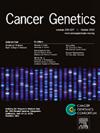SATB2在胰腺癌细胞增殖、迁移和T细胞毒性中起关键作用
IF 2.1
4区 医学
Q4 GENETICS & HEREDITY
引用次数: 0
摘要
目的探讨特殊AT-rich sequence binding protein 2 (SATB2)在胰腺癌(PC)免疫系统中的作用。方法在在线数据库、PC细胞系和PC肿瘤组织中检测SATB2的表达。检测SATB2表达与免疫细胞浸润的相关性。用CCK8检测T淋巴细胞对不同PC细胞株的细胞毒活性。将构建的SATB2过表达和敲低载体转化到PC细胞系中,检测T淋巴细胞活性、癌细胞迁移和增殖水平。最后,对过表达和低表达细胞系进行RNA-seq检测,筛选差异表达基因,并进行qRT-PCR检测。结果SATB2在肿瘤组织中的表达水平明显高于正常组织。SATB2与多种免疫细胞浸润水平相关。SATB2过表达可抑制PC患者T淋巴细胞的细胞毒性,促进PC细胞的迁移,增加s期PC细胞的比例。SATB2过表达和敲除后,PC细胞中有1997个基因差异表达,这些基因参与了B细胞趋化和T细胞分化等免疫过程。结论satb2在PC中高表达,并与不同程度的免疫细胞浸润相关。SATB2还能抑制T细胞的细胞毒性,促进PC细胞的迁移。总之,SATB2被认为是改善PC免疫治疗的潜在靶点。本文章由计算机程序翻译,如有差异,请以英文原文为准。

SATB2 plays a critical role in pancreatic cancer cell proliferation, migration and T cell cytotoxicity
Objective
We aimed to investigate the role played by special AT-rich sequence binding protein 2 (SATB2) in the immune system of pancreatic cancer (PC).
Methods
Expression of SATB2 was detected in online databases, PC cell lines, and PC tumor tissues. The correlation between SATB2 expression and immune cell infiltrations was examined. Cytotoxic activity of T lymphocytes to different PC cell lines was examined using CCK8. The constructed SATB2 overexpression and knockdown vectors were transformed into PC cell lines to detect T lymphocyte activity, cancer cell migration and proliferation levels. Finally, RNA-seq assay was performed on the overexpression and knockdown cell lines to screen for differentially expressed genes and performed qRT-PCR assay.
Results
Expression level of SATB2 in tumor tissues was significantly higher than that in normal tissues. SATB2 was associated with levels of multiple immune cells infiltration. SATB2 overexpression can inhibit the cytotoxicity of T lymphocytes in PC patients, promote the migration of PC cells, and increase the proportion of S-phase PC cells. There were 1,997 genes differentially expressed in PC cells after SATB2 overexpression and knockout, and these genes were participated in some immune processes, such as B cell chemotaxis and T cell differentiation.
Conclusion
SATB2 was highly expressed in PC and correlated with various levels of immune cell infiltration. SATB2 also inhibited the cytotoxicity of T cells and promoted PC cell migration. Altogether, SATB2 is recognized as a potential target for improving PC immunotherapy.
求助全文
通过发布文献求助,成功后即可免费获取论文全文。
去求助
来源期刊

Cancer Genetics
ONCOLOGY-GENETICS & HEREDITY
CiteScore
3.20
自引率
5.30%
发文量
167
审稿时长
27 days
期刊介绍:
The aim of Cancer Genetics is to publish high quality scientific papers on the cellular, genetic and molecular aspects of cancer, including cancer predisposition and clinical diagnostic applications. Specific areas of interest include descriptions of new chromosomal, molecular or epigenetic alterations in benign and malignant diseases; novel laboratory approaches for identification and characterization of chromosomal rearrangements or genomic alterations in cancer cells; correlation of genetic changes with pathology and clinical presentation; and the molecular genetics of cancer predisposition. To reach a basic science and clinical multidisciplinary audience, we welcome original full-length articles, reviews, meeting summaries, brief reports, and letters to the editor.
 求助内容:
求助内容: 应助结果提醒方式:
应助结果提醒方式:


